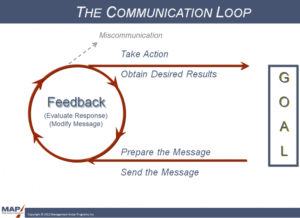Communication Clarity: Transforming Workplace Chaos into Collaboration
Are you finding your employees aren’t meeting expectations? Do they bombard you with questions about their duties or roles, asking things you think they should understand because—at least to you—the answers seem obvious? Or are they failing to hit goals and not following through on certain aspects of their jobs?
If you answered “yes” to any of these questions, there’s a real chance your people don’t fully understand what’s expected of them. They may want to get work done and stick to a plan, but aren’t clear about their roles, responsibilities and expectations. This can create a very volatile situation within your organization’s culture because, without clarity, chaos can reign.
But what’s at the root of this chaos? Usually, a communication breakdown. And the breakdown almost always points back to a lack of clear expectations. When people don’t fully know what they’re expected to do, they may overperform in the wrong areas and underperform in the right ones. Ultimately, this undermines goal achievement, hinders productivity, hurts performance and creates a culture in which there’s not only confusion but distrust, defensiveness, and blame games along with other toxic work attitudes and actions.
The good news is you can take control, starting with three basic, yet important steps:
Commit to righting the wrongs. If you’re sensing that people aren’t doing their jobs, don’t jump the gun and assume they’re not competent or qualified. Take some ownership for any chaos and confusion and discipline yourself to address any communication breakdowns or barriers preventing transparency, understanding, and trust.
Clarify job roles, responsibilities and expectations. Whenever you hire someone, it’s important to give them a document that provides a clear outline of what they will do in their position, so they can set goals, build strategies, and align their activities and mindset around what they’ve been asked to do. If something changes, immediately update those roles and expectations in their job description and make sure they’ve seen and agreed to it to avoid confusion and confirm understanding around what’s being asked of them and, in particular, what’s new. Share these changes with team members who will be impacted, so that it’s clear not just to them but to the entire crew.
Define and communicate “The Goal.” Whether you’re developing a strategic system for accountability, collaborating on a project, running a meeting, or simply brainstorming ideas with your people, always kick things off with this vital question: “What’s the goal?” Defining this before taking action or diving into something saves precious time—which none of us seem to have enough of nowadays—and creates focus—which all of us can appreciate when trying to uphold performance and productivity expectations. Adopting this “What’s the Goal” approach is not just an activity but a mindset that, when practiced consistently, will not just communicate a key objective but align your entire employee culture around it.
Ready to tackle common, yet chaotic communication challenges in your workplace—and get breakthrough results? Contact MAP today!



